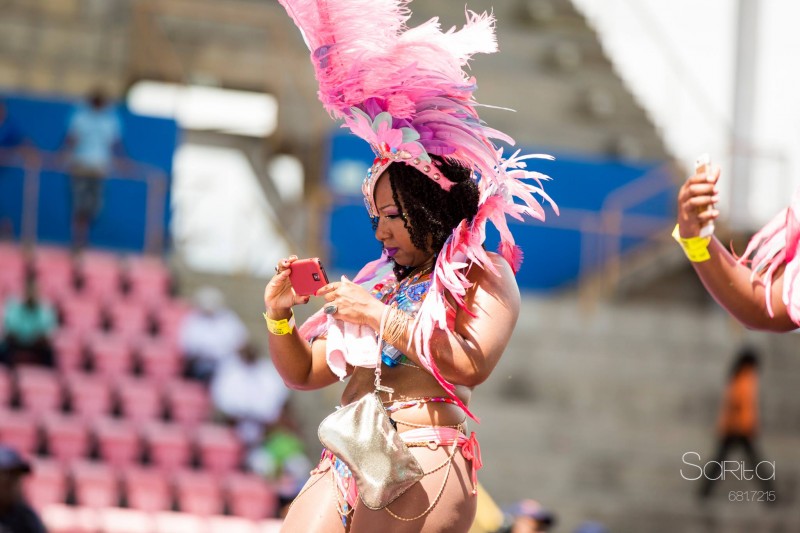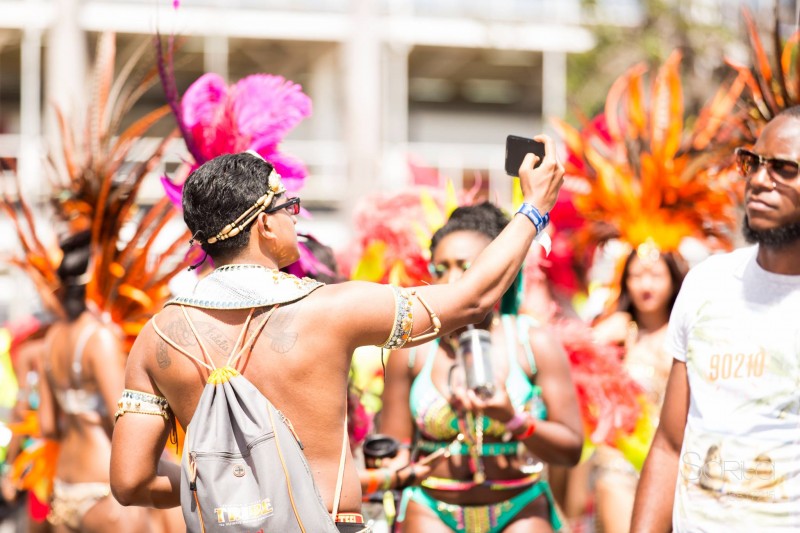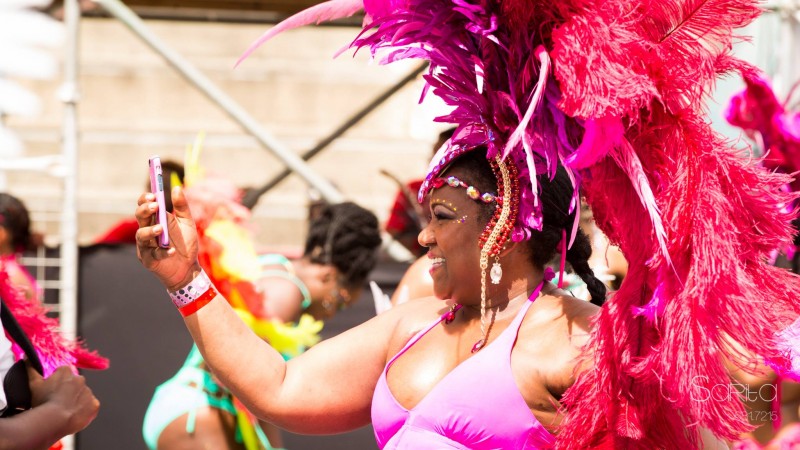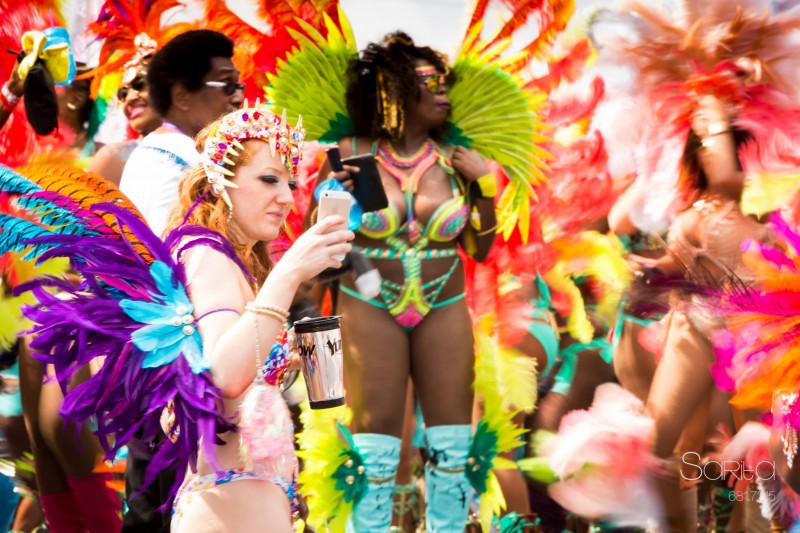
Masqueraders on stage — with their phones — during Trinidad and Tobago Carnival 2016. Image by Sarita Rampersad, used with permission.
Soon after Trinidad and Tobago Carnival 2016 was over, a photo album of the street festivities began to make the rounds on Facebook. Far from what you might expect, the images captured masqueraders who were in two places at once, thanks to their smartphones.
The photographer, Sarita Rampersad, called the collection of images “(Dis)connected Mas” (“mas” is another way to refer to Carnival). She talked to Global Voices about her project, the selfie culture and its impact on the national festival.
Global Voices (GV): This is a pretty telling project. Was this your intent as you went out to photograph Carnival? Or did the topic present itself?

Photographer Sarita Rampersad; photo by Desmond Clarke, used with permission.
Sarita Rampersad (SR): I went into Carnival Tuesday at the Socadrome wanting to shoot more portraits and play with some long exposures, so I went armed only with a 70-200 f/2.8, a polariser and a flash, which is great, but very limiting in terms of how close you can get to the action, so I positioned myself at the exit end of the stage. I realised very early into it that I wouldn’t get anything worthwhile, because I was blocked by a line of photographers and security, so I took some time to look around to see what else caught my eye, and that's when I noticed a proliferation of masqueraders — in the melee on stage, at the edges of the stage, in the stands and on the sides — on their phones. I thought, wow, well this could be interesting, and started to shoot them instead.
GV: What do you think your images say about our society — and our Carnival?
SR: I don’t think the images tell just one truth. You can look at them and see society as self-obsessed and narcissistic, and you can look at the same images and see revelers trying to share their experience with as many people as they could. Cell phones have become such an extension of ourselves that it hardly registers in your mind ordinarily, but the absorption in them struck me on Carnival Tuesday, maybe because the festival itself is supposed to be one that you lose yourself in and that you revel in with the people around you. The reflex action of masqueraders looking to their phones first for validation (either in selfie form or communicating with whoever was on the other end), often to the exclusion of what was happening around them, was very interesting, because to me, it showed how much more important virtual reality was at that moment, than actual reality.
One commenter pointed out to me that it was easier for her to deal with people electronically than face to face, so her using her phone allowed her the freedom to look social without having to actually talk to anyone. Carnival has evolved into a luxury, all-inclusive experience that people want to be seen to be a part of. If someone spends TT $6,000 on a costume [just under US $1,000] in a sought-after band, they would want as many people as possible to see them having fun. Selfies to share on Facebook and Instagram and live streaming on FaceTime and Periscope are real time ways of reaching as wide an audience as possible on their own terms.
GV: Do you think the fact that the festival had few spectators encouraged the use of phones even more? Were masqueraders trying to drum up their own (albeit virtual) audience?
SR: I think they may have been. As a masquerader myself, energy and reaction from spectators is a vital part of playing mas. The mess that the NCC [National Carnival Commission] and the various carnival bodies have made of Monday and Tuesday mas has split bands and photographers across venues and has had the effect of spreading spectators out too thin. There’s also the sad fact that as a show, Carnival has become a huge failure. It’s a fantastic street party, but unless you’re one of the people playing mas, there’s really nothing to see and enjoy.
As a caveat, I’d like to mention that bands like K2K and now The Lost Tribe are doing their part to revive the spectacle of carnival again, so there’s hope that the ‘show’ in the greatest show on earth will return to mas and give spectators and masqueraders a reason to engage with each other once more.
GV: What kind of commentary do you think this experiment has made about selfie culture?
SR: The availability of information and exposure to pop culture 24/7 has given us new ideals to aspire to, and social media is a platform that allows us to be just like the celebrities we admire. There’s a hunger for external validation that social media both created and satisfied in us — the more ‘Likes’ we have, the better and more popular we are; the better and more popular we are, the more likes we’ll get. And our reach is now global. The obvious commentary on selfies other than it being trendy, would be that we’re becoming more and more narcissistic, egocentric and self-absorbed. Less obviously would be the social, inclusive nature of the selfie. Friends who are in one place can include those who aren’t physically, thereby sharing a picture that shows they’re thinking of them. It’s very easy to draw conclusions when you’re an objective outsider taking pictures of people taking pictures, but the intent behind each person’s shot, selfie or otherwise, is an important part of their narrative.
GV: What was your impression of your subjects? Was everyone as they appeared — missing the experience of the moment because they were too involved in capturing it? What was the vibe on the streets like?
SR: I differentiated between masqueraders on their phones and those taking selfies and photos in my Facebook description, because I saw some difference in the way they experienced Carnival and interacted with those around them.
I took many, many photos where you would see a shot of a girl on the phone for instance, surrounded by friends, and about 10 minutes later I'd take another shot in that same location and she would still be on her phone, with her friends looking bored next to her. Another shot for example, would be a guy surrounded by girls in costume, but his head buried in his phone. I didn’t get the impression, based on my observation of them, that they were engaged in capturing any aspect of carnival, so much as using their phones the same way they would in any other situation. I appreciate wanting to let friends know where you are and arrange meeting points etc., but what struck me repeatedly was how engrossed the masqueraders were in their devices and how removed they seemed to be from Carnival and what was going on right next to them.
The cell phone photographers drew my attention in a different way. They were very social and involved in capturing the festivities, but it was pretty interesting to see them instantly bend over their phones to upload the images they'd just taken to social media.
The vibe on the street was a bit different — there was less concentration of masqueraders on their phones and more of them performing for the cameras. People seemed a bit tired, like they were going through the motions by the time they got to halfway down Ariapita Ave. [a main causeway] at around 2/3 p.m., but they came back to life once they got to the Synergy stage [along that same route]. Again, it was interesting to note the rejuvenating effect cameras had on the masqueraders.
GV: Has technology helped or hindered the experience in this regard?
SR: Technology has a very important role to play in the evolution of the way we market Carnival. The attempts to control copyright of images coming out of Carnival by the NCC, NCBA [National Carnival Bands Association] and TTCO [Trinidad and Tobago Copyright Collection Organisation] have made professional photographers wary and weary, and more and more, the world is seeing this festival through the eyes of masqueraders and less through the lenses of pros.
This is both empowering and sad, because while the quantity of imagery is increasing, the world at large is missing the magic captured year after year by the Butch Lim Choys and the Andrea De Silvas, the Mark Lyndersays and the Maria Nunes‘, who are forced to be more selective about what and where they shoot and how they can share.
GV: If you were to predict how we play mas in 10 years, what would it be like?
SR: On the flip side […] technology is also dictating the way we play mas, making us more performers for a camera, and less revelers losing ourselves in the experience. For all we know, Carnival might become a completely virtual phenomenon, with the advent of things like Google Cardboard and 360 videos, with masqueraders sculpting perfect road worthy avatars, buying a costume in the app store and strapping on 3D goggles instead of backpacks!
I would like to think that we’d reach a point where the fun and joyous abandonment would be more important to masqueraders than stopping to capture and share blocks of time and that professional photographers would have the freedom to cover and disseminate imagery as they please without prehistoric bureaucracies stifling them, but in reality, I think the opposite will occur and the only imagery coming out of Carnival will be cell phone and point and shoot imagery, and the marketing will be mainly social media and out of touch advertising by our sluggish Carnival bodies.
GV: As a photographer, where do you stand on the selfie? A cry for attention or a tool for self-expression?
SR: As a photographer on Carnival Tuesday, I appreciated the entertainment and opportunity to shoot something a little different — especially as I found the Socadrome underwhelming as far as a show went. I’m not against selfies, although I’m incapable of taking a good one myself. It’s great that technology has given people the opportunity to capture themselves on their own terms and I’ve found that the people that would engage in selfie behaviour generally can’t get enough images of themselves, so they don’t stop you from taking your own pictures of them, and are in fact quite willing to pose for ‘professional’ shots as well.
There are of course, also instances where the selfie is used solely for show and to portray something that isn’t reality. A friend of mine, Antony Scully, who was also shooting at the Socadrome on Tuesday, saw a lady walking off the stage with phone in hand trying out different selfie poses to find the most flattering. When she did, she looked around and grabbed a guy dancing past and wined back on him, all the while holding the phone in selfie position. When she was happy with the shot she got, she turned and waved him off and they both went about their business!
GV: What happens once these images are posted on social media? What do you think is the ripple effect of this culture?
SR: There’s no one reason we’re becoming who and what we are, but tying this into Carnival, wanting and needing to be seen and heard generally can also be a reason for our compulsive selfie and posting behaviour. We’ve been given another way to speak through social media platforms, but the sheer volume of all the voices around the world trying to speak at the same time, means you have to learn to be very loud in that space. Once you upload images to social media, for instance, they get lost in the clutter very quickly, because there’s tonnes of imagery bombarding you every day. As a poster, you have to have a specific plan to keep your images alive, whether it be releasing one a day, or tagging people sporadically, or commenting/sharing randomly to bump them in newsfeeds. We’re constantly subjected to and on the hunt for new stimuli.
GV: Did Carnival — and the masqueraders — lose or gain something via the mass selfies?
SR: Carnival as a money making entity can only gain by the imagery taken and shared during the event. If, as a masquerader, your intention during Carnival is to lose yourself in the celebration and fun of it, being surrounded by selfie takers can be a distraction and encroach on your good time, especially when they’re standing still to take one and you have to be cognisant of them or risk wining into them. If you’re all about being seen to be having fun, then selfies/sharing would only add to your experience, because your motivation for being there in the first place, is different.













3 comments
Very interesting read. Well done.